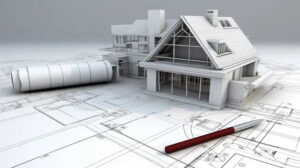BIM 3D modeling services to building design engineering
BIM allows all stakeholders (architects, engineers, contractors, and owners) to work on a single, shared model. This enhances communication, reduces misunderstandings, and improves collaboration.
Enhanced Visualization: BIM 3D modeling provides detailed 3D models that help stakeholders visualize the project at different stages. This aids in better design decisions and helps clients understand what the final product will look like.
Increased Efficiency and Productivity: By integrating various project data into one model, BIM reduces the need for rework and minimizes errors. This streamlines workflows and increases productivity.
Cost and Time Savings: BIM helps in accurate quantity take-offs and cost estimation. It also aids in scheduling, allowing for better project planning and management. This reduces delays and budget overruns.
Improved Quality and Safety: BIM 3D modeling helps identify potential issues early in the design phase, allowing for proactive problem-solving. This leads to higher quality outcomes and enhances safety by anticipating and mitigating risks.
Lifecycle Management: BIM supports the entire lifecycle of a building, from design and construction to operation and maintenance. This holistic approach ensures better facility management and easier renovations or expansions.
Sustainability: BIM 3D modeling enables better energy analysis and sustainability assessments, helping to design more energy-efficient and environmentally friendly buildings.
Regulatory Compliance: BIM helps ensure that the project meets all regulatory and compliance requirements by providing detailed documentation and tracking changes.
Overall, BIM is a transformative tool that modernizes the construction industry by making processes more efficient, collaborative, and sustainable.
Key aspects of BIM include: 3D Modeling: Provides detailed 3D visualizations of building components. Collaboration: Facilitates better communication and coordination among stakeholders.
Efficiency: Enhances productivity by minimizing errors and reducing rework.
Lifecycle Management: Supports the entire lifecycle of a building, improving maintenance and renovations.
Cost and Time Savings: Helps in accurate cost estimation and scheduling, reducing delays and budget overruns.
BIM is transformative in the construction industry by promoting more efficient, sustainable, and collaborative project management.
-
Key aspects of 3d BIM Modeling include:
3D Modeling: Provides detailed 3D visualizations of building components.
Collaboration: Facilitates better communication and coordination among stakeholders.
Efficiency: Enhances productivity by minimizing errors and reducing rework.
Lifecycle Management: Supports the entire lifecycle of a building, improving maintenance and renovations.
Cost and Time Savings: Helps in accurate cost estimation and scheduling, reducing delays and budget overruns.
Benefits of 3D BIM modeling services:
- Efficient design data management with 3D BIM objects
- Rapid clash detection and resolution
- Streamlined construction planning
- Smooth transition from 3D models to 4D BIM
- Facilitated offsite construction processes
- Reduced on-site risks
- Seamless coordination with sheet metal contractors and fabricators
- Efficient collaboration with building product manufacturers
- Streamlined workflows between general contractors and subcontractors
Acurabim Engineers is a leading provider of exceptional 3D modeling services, designed to present your product’s features with unparalleled realism and clarity to your target audience. Our team of experienced professionals offers a wide range of services, including product design, architectural visualization, animation, and virtual reality, all aimed at bringing your ideas to life and achieving your business goals.
Utilizing the latest technology and software, our 3D product modeling company creates accurate, lifelike models that meet our clients’ specific needs. With extensive experience across industries such as manufacturing, engineering, architecture, and advertising, our skilled team ensures precision in every project. By incorporating client product samples and consumer preferences, our 3D modeling studio delivers optimal results every time.
Feel free to connect with us sales@acurabim.com
Our 3D BIM modeling services include:
- Converting 2D AutoCAD drawings into 3D BIM models using Revit/BDS
- Creating 3D graphical representations of building and construction plans
- Coordinating designs in a Common Data Environment (CDE)
- Developing 3D BIM coordinated models following LOD 100 to LOD 500 AIA standards
- Producing fabrication and installation drawings for MEP & HVAC systems
- Creating 4D BIM models to visualize construction timelines from 3D BIM models
Follow us on linkein for more updates


